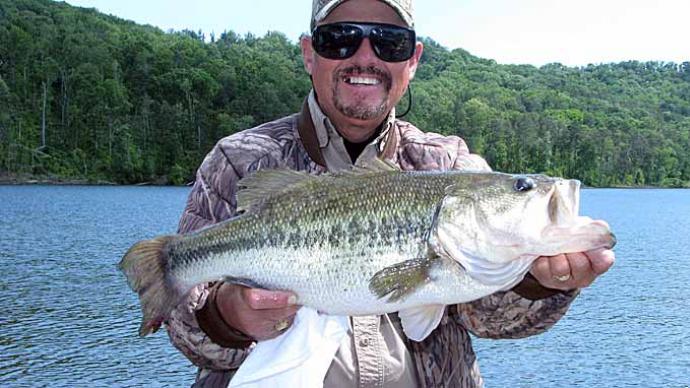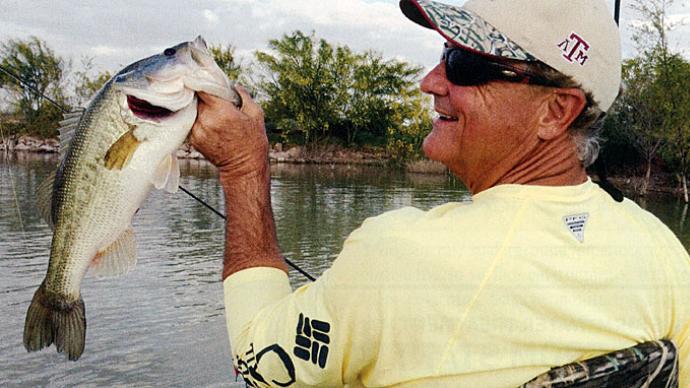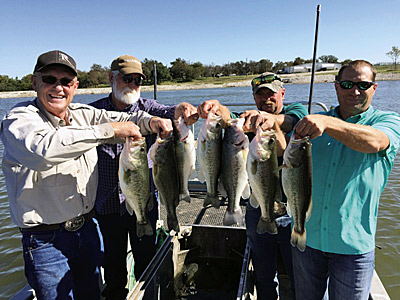
Okay, so you are one of those good folks determined to push your lake beyond what nature would normally allow?
Fine by me—as long as you understand the consequences, and those pesky limiting factors. And, as you think things through, it helps to know what nature would truly do with your pond, all things being equal and with you offering no management help. What would happen, if left to its own resources? It's good to know that, for contrast with what you think you'd like to do.
You've studied all about habitat, food chains, great genetics, and a good harvest plan, and how those fundamentals might apply in your specific situation. Heavy on those words, your specific situation. But, you've really struggled with that harvest thing. Why be forced to take out so many of those top line predator fish? Who wants to fillet a ten or twelve inch bass, much less hundreds of the little darlings? Why not push them to grow larger? Just give them more food, grow more baitfish, and figure out how to have more, and bigger game fish? Sounds easy, and simple.
It's not.
Because there are limiting factors.
As a consulting fisheries biologist, I've seen many, many ponds and lakes over my 37 years of studying this stuff. I've seen lots of limiting factors. They all have things in common. Each limiting factor has a tipping point. Your job is to figure out what that means.
In almost all ponds, the number one limiting factor is food. Still sounds pretty simple, doesn't it? Add more food, grow more fish. And, grow more big fish.
Problem solved.
Nature doesn't work that way, you've heard. But, you've been successful with other ventures in your life and you're determined to figure out how to beat this deal, too.
It's easy to assume adding some feeders, and feeding a high-quality, high protein fish food will quickly increase productivity. That's surely true, especially for the middle and top of the food chain, with some trickle-down impact. Feeding fish leads to more fish and more fish waste. Some of that waste will be picked up by other organisms and converted to protein, available to return to the food chain at a lower level. But, some of that waste ends up as raw fertilizer, or even compounds that fish can't handle.
Depending where you live, fertilization can be an excellent way to build the bottom of your food chain. While this story isn't about the food chain, it's important to know nature's food web begins with nutrients that feed phytoplankton, which feeds zooplankton, which feeds bugs and little fish, and so on, up the chain.
Studies over the years suggest fertilization increases production four-fold and feeding adds another increase, which can push beyond 100%. That's quite an impact over zero management— for contrast.
Let's presume you can remove food as the number one limiting factor. You can add much biomass to your lake via those two simple avenues. That gets you part of the way to your goals. You overcome that limiting factor, so what's next?
Water quality.
Here's a key principle in managing an environment, especially your pond. Every decision you make, on which you act, has consequences. Your job is to have a reasonable expectation of those consequences. For every action you take, there's a reaction. If that reaction, or consequence, is what you want, you made a good choice.
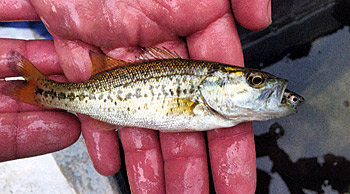
As in much of life, it's not what you know, it's what you don't know that stymies you. Experience is a great teacher. But, with your precious pond and its fishery, you don't really want to learn from experience, if it's a bad experience. That's because, at the very least, you lose time, and worse, you lose your fish and the time it took to get to that tipping point.
Here's a case in point. One landowner, in the south, decided to push his fishery. On his ten-acre lake, he put twelve feeders, each one set to go off three times a day during the warm months. His goal was to have feed-trained Largemouth bass, with a goal of growing some record-size fish over the long haul. He knew that water quality would most likely be his biggest limiting factor, so he worked with a vendor who designed an aeration system. Being the aggressive kind of guy he is, with a better-than-average budget, he tripled the aeration recommendation made by the vendor.
He figured three times the aeration would move the water three times as much, and do more to process excess fish waste and make sure his lake stayed aerated from top to bottom. What he didn't know caused a minor heartache. He reported a few of his prize fish dying every day, for most of two weeks. Those fish were two to three pounds, some slightly larger. No other species were dying, no bluegills, and no redear sunfish, none of the smaller bass or threadfin shad—just the largest bass in the lake, of course.
There was no obvious cause of death. A pathologist found no abnormal disease organisms or virus. There were no lesions, no sores, no holes poked by birds. Most biologists presume that after food, water quality is the next limiting factor, which it is. If water quality isn't limiting, then crowded fish are more susceptible to disease. Logically, disease is the third limiting factor.
Not in this case. Water was tested, oxygen and temperature were regularly recorded. Nothing out of the ordinary. Oxygen, during the hottest months, was never at 100% saturation, even with the rigorous aeration. But, it never dropped to lethal levels, either.
What possibly could be that limiting factor?
Why were the fish dying? Why were just a few floaters rising, not masses?
After consulting with his experts, the decision was made to cut back on the feed. It made sense to reduce nutrient input and see what happened. As everyone proverbially scratched their heads, he didn't want to lose precious fish, or precious time growing those fish. Half the feeders were turned off, the other half were decreased, although fish were feeding heavily at the time.
In this case, keep in mind it was the dog days of summer, when temperatures on his part of the planet boasted lows in the mid-80s and highs in the upper 90s.
Fish still died, one to three at a time, each day. Now, the totals were knocking on the door of 40 fish over a period of four weeks. He'd stocked 1,000 of those fish 15 months earlier, averaging about a pound apiece.
After more consulting, there was a clue. Water temperature, with his three-times over the recommended aeration rate, stayed 87 degrees, autonomous from top to bottom. For largemouth bass, that's hot. Could that be his next limiting factor?
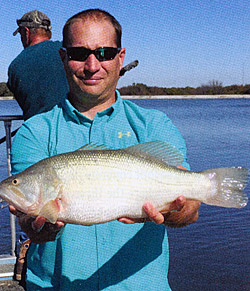
The decision was made to change the protocol for his aeration plan. Biologists know that nature provides a thermal refuge in natural lakes. But, not in this lake. 87 degrees was hot, and the theory was that his water was too warm for bass and some of them perished after sustained days of hot weather. He cut his aeration by half. Oxygen levels weren't impacted and water temperatures dropped a little bit—into the mid-80s.
Mortalities dropped a little bit, but didn't cease, until fall temperatures dropped water temperatures into the 70s. Fish stopped dying, feeding was increased, and things were clicking again. Water temperatures looked like the limiting factor of the moment.
So, how to keep that from happening again next year? His plan is to be creative with his aeration strategy, putting it on a timer from dark until dawn, when water temperatures are coolest in hot summer months. Other months, he'll run it 24/7 until late fall, when temps drop into the 50s. Then, he'll shut it off.
Here's another case. You may be familiar with legendary Richmond Mill Lake, in North Carolina. Home of the King Fisher Society, Richmond Mill Lake was built in 1835 to harness water to turn a gristmill. The lake was drained in 2000 to rebuild a shaky dam. When the lake was ready to receive water again, in 2004, the owner, the Morgan Company, led by Dr. Jim Morgan, set a goal of turning this lake into a destination fishery. But, there was a problem. A big one. History had proven this lake couldn't raise a bass if its life depended on it. Water flowed over the spillway at 7-10,000 gallons per minute, manifested as springs coming through the sandy soils of that area. Toss in the fact the water was acidic, with a pH consistently 5.3, and you have fast flowing, non-fertile water with no chance of being amended to create a significant food chain. Dr. Morgan decided to create a 125- acre lake totally dependent on fish food. Armed with some strong pro formas and projections for a destination business and targeted capital to make it happen, Dr. Morgan pulled the trigger on a substantial feeding program and aggressive stocking regime with feed-trained bass, bluegill, and other forage fish.
Fast forward four years and that lake was producing a significant bounty offish. Some of them were growing exceptionally large, especially the bluegills. By the fifth year, anglers were catching big numbers of two-pound-plus bluegills. Bass pushed beyond five pounds by then.
Food wasn't the limiting factor. Water wasn't, either. The consistent flow and consistent water quality, even though the water was sterile, ended up being a blessing. What became the limiting factor for this fishery? There were two distinct limiting factors. Disease? Nope. Seems water so acidic limits the numbers and types of pathogens that can survive.
The limiting factor in this lake became the successful bounty of fish. Richmond Mill Lake became a slight victim of its own success. That lake became a magnet for predators. Cormorants haunted the place on both migratory trips each year. Ospreys figured out there was free food, and a mated pair set up shop. One of the coolest experiences of that lake is watching the Ospreys as they raise their young, flutter and hover over the lake, and dive bomb dinner. Bald eagles come fairly often, unless the ospreys take issue. River otters set up camp there, until the manager figured it out and encouraged their exodus. There was even one span of about a month when anglers saw a six-foot alligator poaching.
Oh, and for a few months, the manager thought he had a problem with some of the feeders. All 40 feeders sit on top of stainless steel platforms set in the lake. Several feeders went empty way too often. Timers were traded, but the problem continued. The manager had an idea. He'd seen some signs of raccoons from time to time, but would a raccoon swim 150 yards into the lake, climb atop a platform and spin the spinner plate to eat? He set some traps and ran them daily. Over a two week period, he caught 98 raccoons. Yes, you read that number correctly.
Richmond Mill Lake, a bountiful producer, attracted a significant number of nature's consumers. The other limiting factor? Budget. For the projections to meet with the actual business, there had to be a budget for fish food and feeder maintenance. Between those two, the fishery began to reach its balance, which is still way above anything nature could provide in that body of water.
What could be your limiting factors, your missing links? As you ponder your strategy, give this some thought. Every body of water, every fishery, and every ecosystem has its limits. Your job is to think beyond the obvious and give yourself the best chance to win, by knowing the risks of what you want to do.
Reprinted with permission from Pond Boss Magazine


